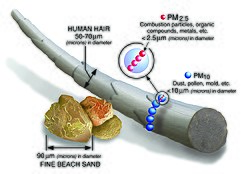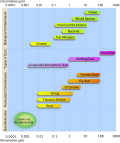Particulate
Particulates are very tiny pieces of a solid or liquid that are carried floating in a gas. When the tiny pieces are solid, it is called a smoke. When the tiny pieces are liquid, it is called an aerosol. Aerosols can be naturally found in clouds and geysers. There are also artificial aerosols such as haze and some air pollutants. Smokes can be found naturally in wildfires and volcanoes. Artificially, they can be found in cigarettes, factories and power plants. Both of them can cause air pollution and climate change. It is the job of a air filter to remove them.
Particulate Media
PM2.5 and PM10 compared with a human hair in a graphic from the Environmental Protection Agency
Particulate emission when using modern electrical power tool during home broadband installation, Tai Po, Hong Kong
Excavator (a type of heavy equipment commonly used at construction sites and roadworks) demolishing the remnants of the pre-war Postal Train 0880Station (Dworzec Pocztowy) at Jerozolimskie Avenue, Poland
Global aerosols portrait produced by a GEOS-5 simulation at a 10-km resolution, August 2006 - April 2007.*Red/orange: desert (mineral) dust*Blue: sea salt*Green: smoke*White: sulfate particles
False-color maps are based on data from the Moderate Resolution Imaging Spectroradiometer (MODIS) on NASA's Terra satellite. Green: aerosol plumes dominated by larger particles. Red: aerosol plumes dominated by small particles. Yellow: plumes in which large and small aerosol particles are intermingling. Gray: the sensor did not collect data.
Fabric filters Hepa effect: without (outdoor) and with filter (indoor)
Global aerosol optical thickness. The aerosol scale (yellow to dark reddish-brown) indicates the relative amount of particles that absorb sunlight.
Average monthly aerosol amounts around the world, observations from the Moderate Resolution Imaging Spectroradiometer (MODIS) on NASA's Terra satellite.
Italian city polluted by particulates and optic air detector (laser)




